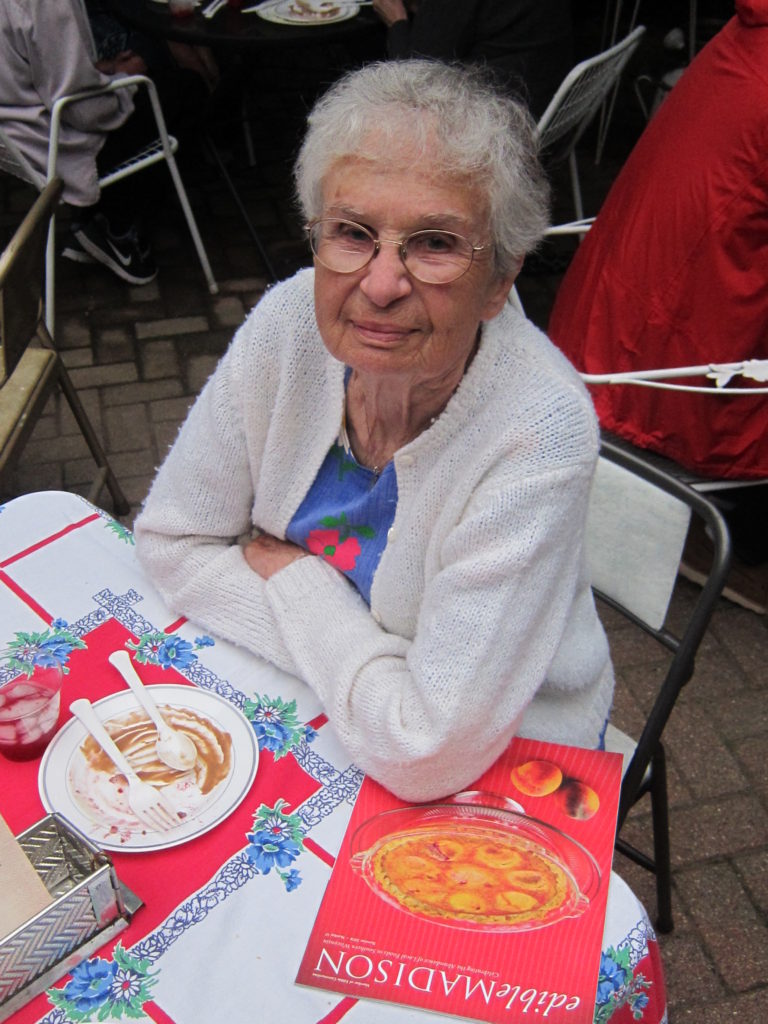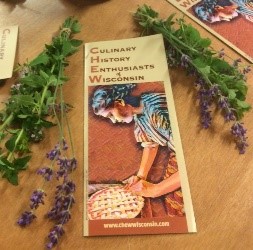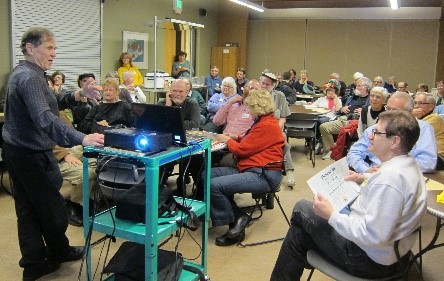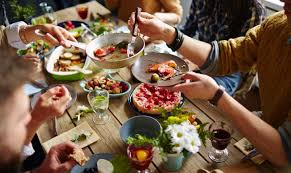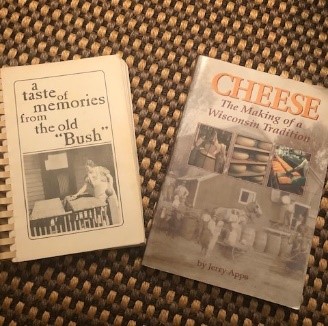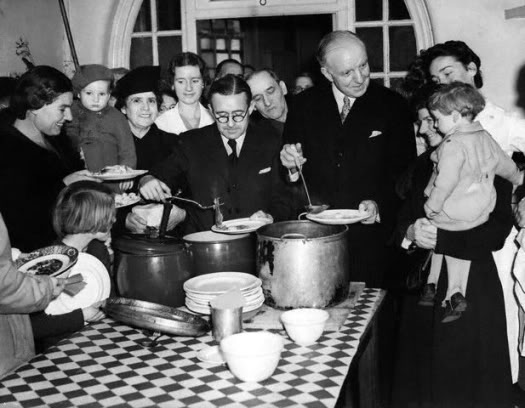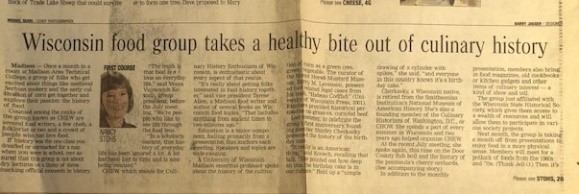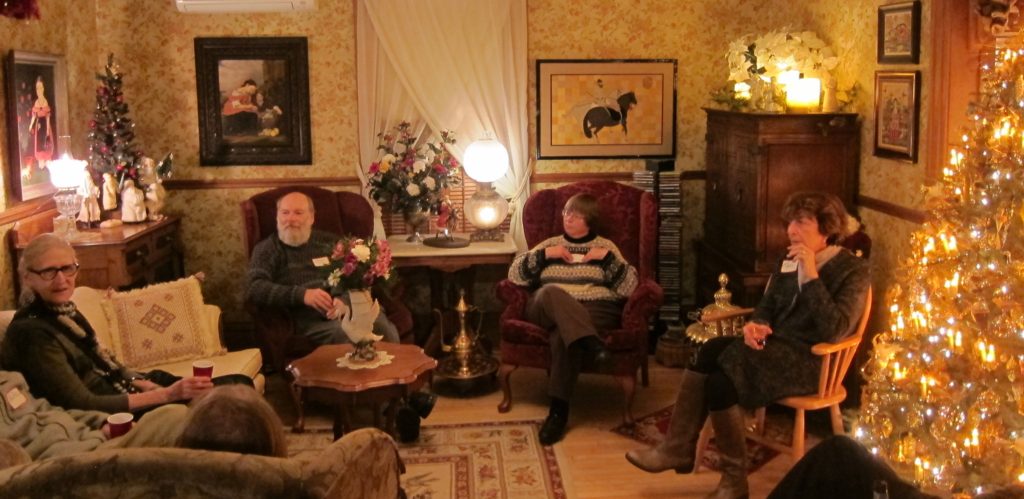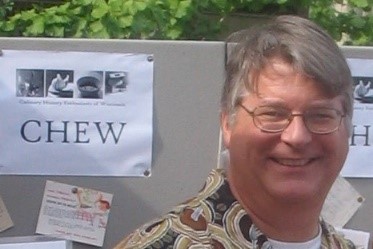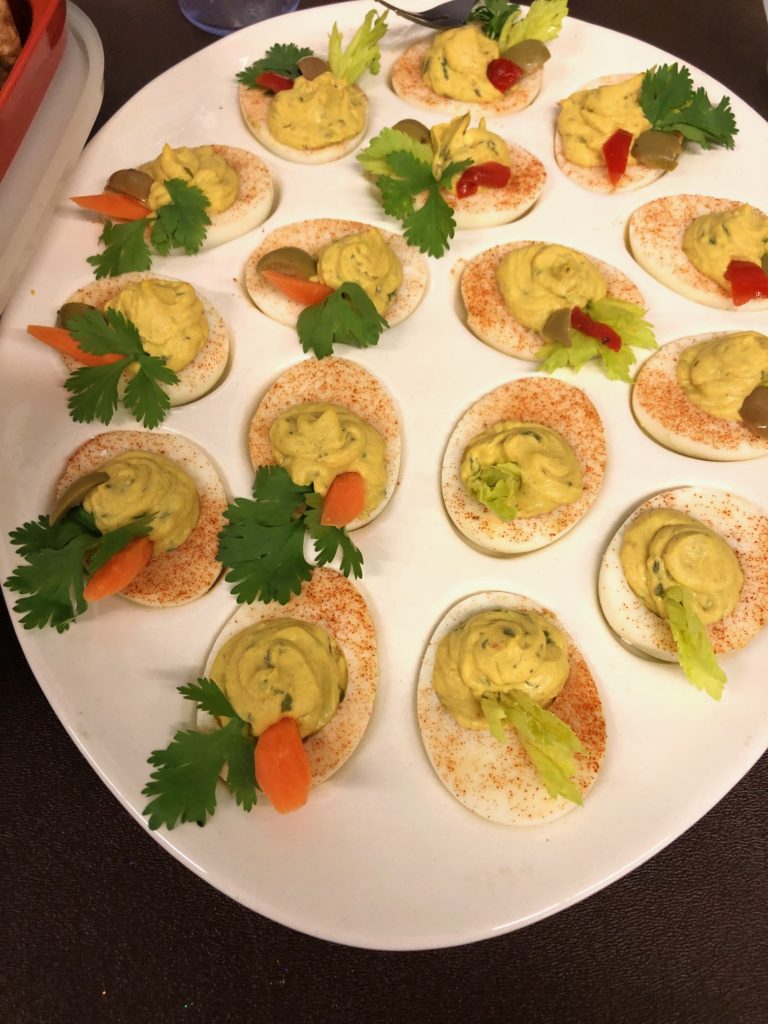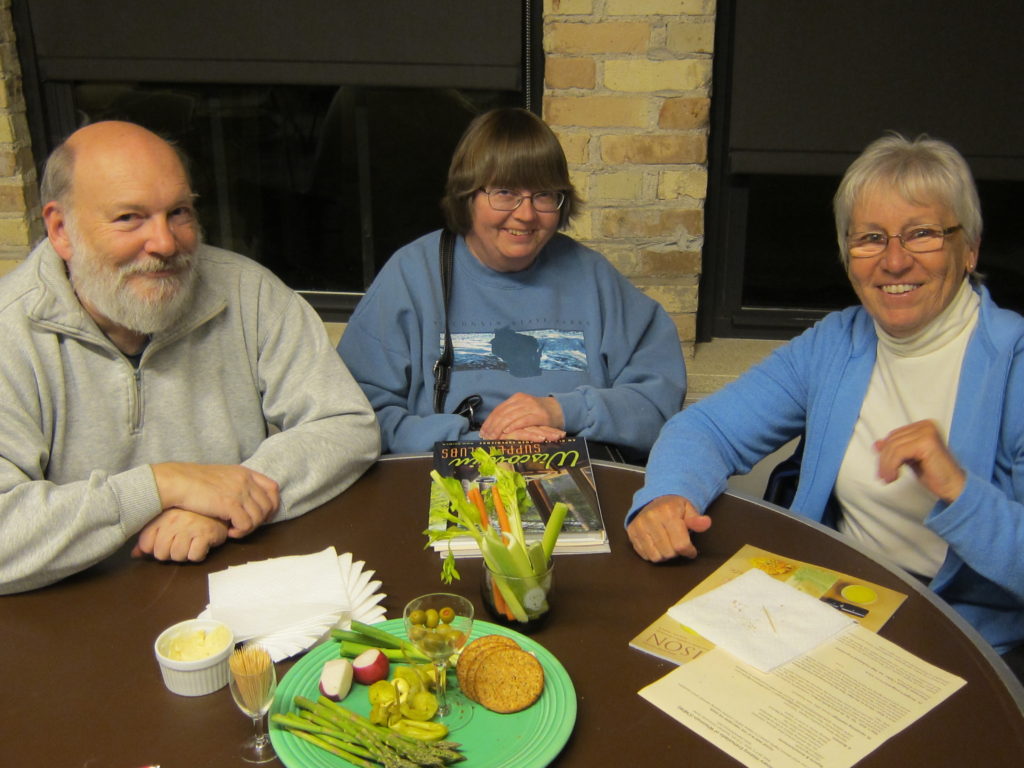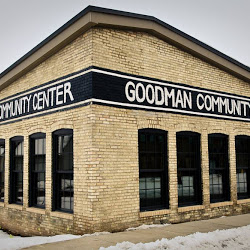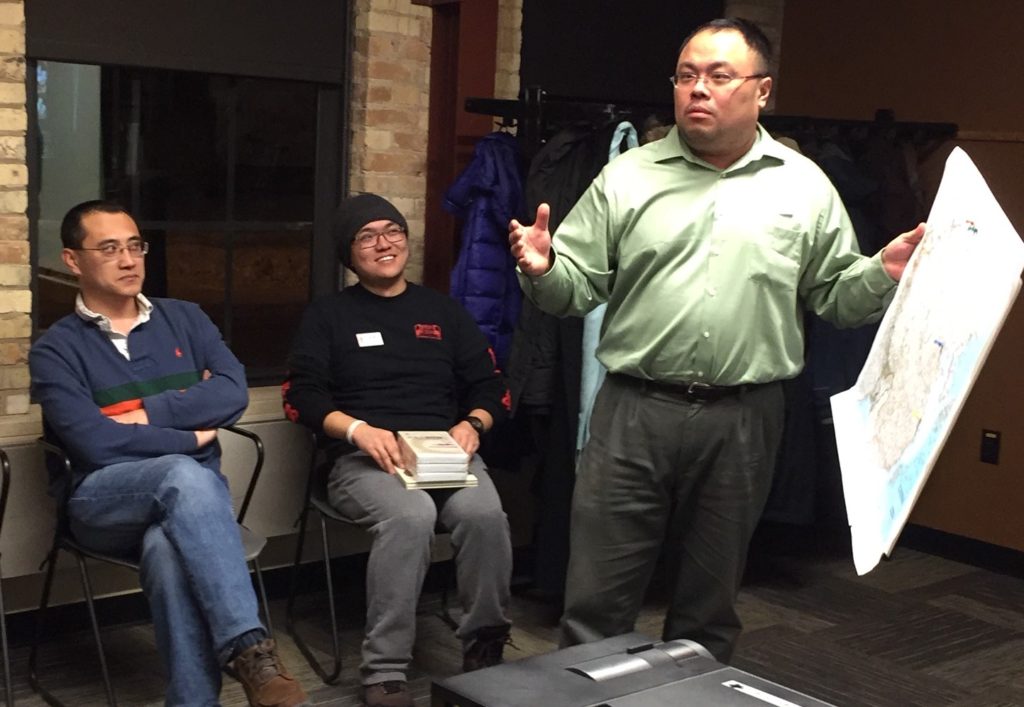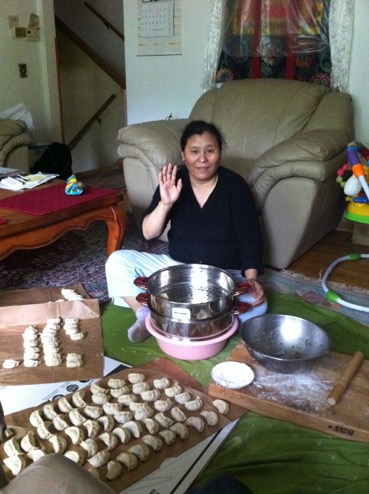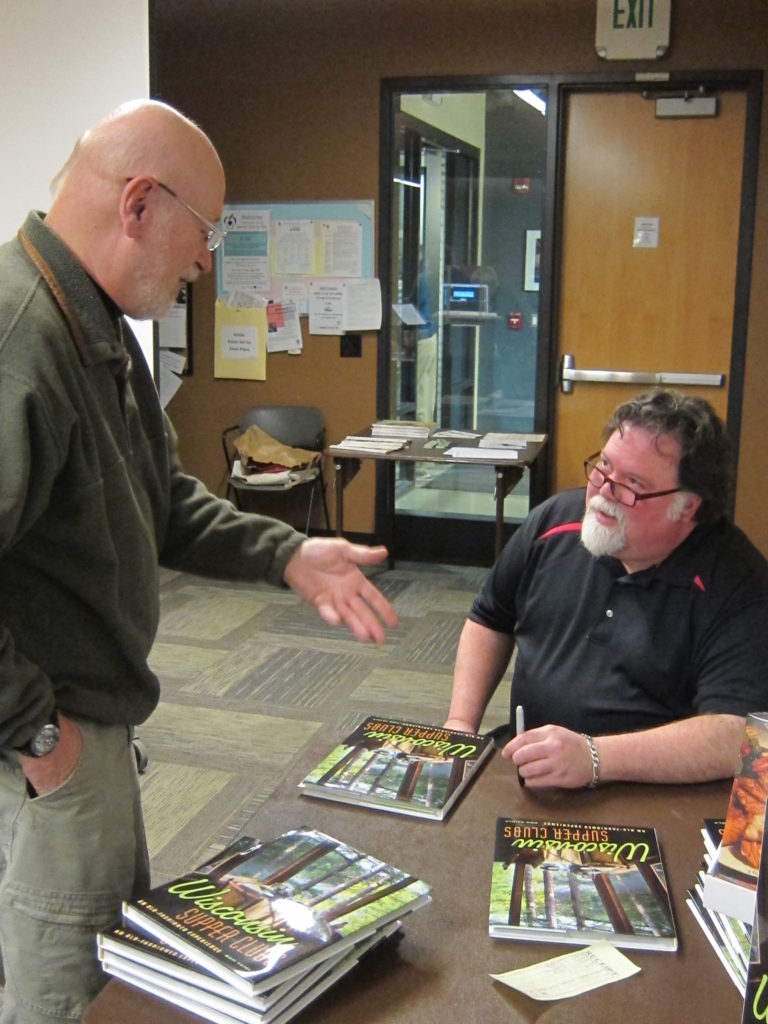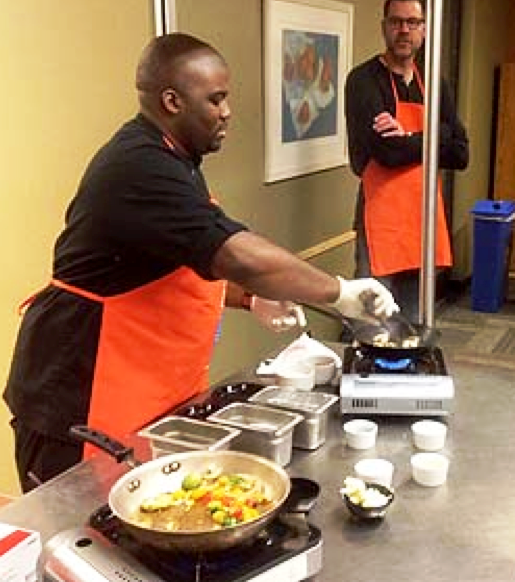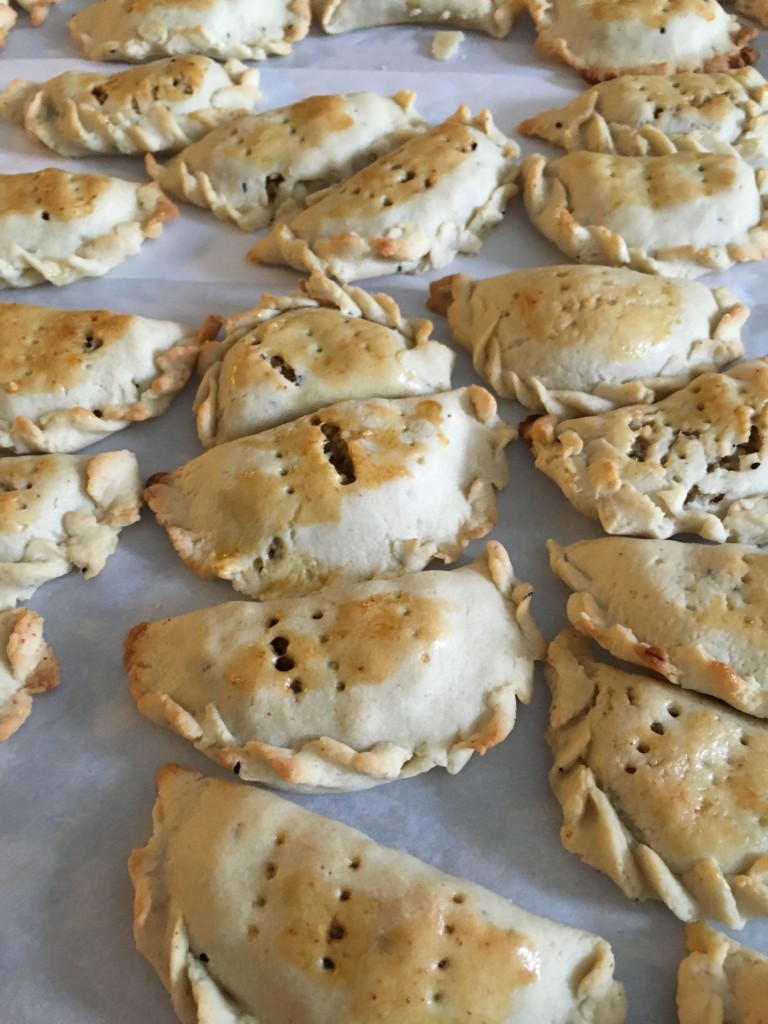CHEW, or the Culinary History Enthusiasts of Wisconsin, was the brainchild of Shirley Cherkasky, a retired historian who worked many years for the Smithsonian Institute in Washington, D.C. Shirley spent her summers in Madison, and while there in 2000 she got in touch with local food writer Terese Allen to propose the idea of a group similar to one Shirley had founded in Washington, D.C.
Terese knew of numerous people in food-related groups and businesses in the region, and drew up a list of potentially interested participants to share with Shirley. Joan Peterson, a food-travel writer and publisher, also shared names. And soon the inviting began.
The first three gatherings of interested parties took place in the summer of 2000 and were held at Union South on the UW Madison campus. These early meetings were largely discussions about what the group might become, how it would be structured, and what would take place at meetings. The list of potential members also grew as attendees offered more names, of everyone from professional chefs to home cooks, and from cookbook authors and local historians to folks just interested in learning more about the world through the lens of food. (The term “foodie” was still relatively new back then, but that’s what we all were, essentially.)
Our early group of food history lovers gravitated towards the structural model of the Culinary Historians of Washington, D.C. (the organization that Shirley Cherkasky had founded and led), which is a membership-based group that holds meetings featuring an invited speaker. To this day, CHEW presentations are followed by group discussion, and the in-person meetings feature cooking demonstrations and/or food samples to share. Field trips, banquets, annual potlucks and other special events are also sometimes part of the CHEW schedule.
Early on, we decided that our meeting topics could cover any aspect of food history from around the world and throughout time, with a liberal sprinkling of topics specifically related to Wisconsin and the Midwest. We’d aim for an eclectic, educational but also entertaining mix. We’d draw from academic, culinary, agricultural and other fields to find speakers. We’d be not-for-profit and open to all, and would keep dues affordable. (The latter, in fact, is still at its original level: $25 per year). We’d establish a mission, develop by-laws and get “official.” We’d use the working title of “Culinary Historians of Madison” until we chose a permanent name.
To get the ball rolling, we decided to look to each other for potential speakers.
The first “official” meeting, one with a scheduled presentation, was on October 4, 2000, and was held at Madison Area Technical College (Truax Campus). We moved to this location because MATC baking instructor and early CHEW member Punky Egan was on the faculty there and could get free use of the school’s teaching kitchen and a meeting/dining room, with free parking to boot.
CHEW’s first speaker was Lou Pitschmann, associate director for collections with UW-Madison’s library system. Lou was also the fledgling food history group’s first moderator. His talk, called “More Than Recipes: Using Cookbooks to Measure Immigrants’ Assimilation into American Life, 1818-1819,” explored how recipes and food habits changed rapidly among European immigrants during the 19th and early 20th century, and how they eagerly took to traditional American recipes.
CHEW was off to an intriguing start.
After Lou’s talk other early members of the organization offered presentations. Terese Allen followed Lou with “Booyah, Bratwurst and Limburger Cheese: The Food and Folklore of Wisconsin,” which looked at how Dairyland foodways reflect the state’s history, culture and personality. Food travel writer Joan Peterson featured exotic foods from around the world in “Exploring the Ethnic Kitchen” (one specialty that garnered a lot of interest at that meeting was the stretchy Turkish ice cream called sahleb.) Folklorist Janet Gilmore gave us “Boiled, Roasted, Dried and Frozen: Fish Foodways in Great Lakes Subsistence.” Other early topics and featured speakers included:
–Rural historian Jerry Apps, “Cheese: The Making of a Wisconsin Tradition,” featuring his book of the same title,
–Catherine Murray, author of A Taste of Memories from the Old Bush (a multi-ethnic neighborhood on Madison’s west side that was razed for urban renewal), with recipes an oral history,
–Attorney (and National Mustard Museum curator) Barry Levenson, on food-related legal cases from his book, Habeas Codfish.
CHEW’s first officers were: Vesna Vuynovich Kovach (president); Terese Allen (vice-president); Leslie France (secretary); and Punky Egan (treasurer).
During CHEW’s first year or two we: elected officers; formally named the organization; established its mission and several committees (including Publicity, Membership and CHEW History); and, after much passionate discussion and a lot of help from CHEW Secretary Leslie France, we ratified our by-laws (in fall of 2001). In 2002, CHEW member Traci Kelly developed and then became the manager of the CHEW website. (Later on, she also produced our first promotional brochure and set up our Facebook page.)
News coverage about the burgeoning organization included articles in Madison’s Isthmus and Eastside News, The Capital Times and the Milwaukee-Journal Sentinel. (“If history was the one class you dreaded or earmarked for a nap when you were in school,” wrote Nancy Stohs of the Journal-Sentinel, “rest assured that this group is not about dry lectures or a litany of dates marking official moments in history.” She went on to describe the food, the lively discussions, and to quote some of the members.)
CHEW eventually began publishing a newsletter, called CHEW’sletter, which is mailed out monthly (except August) to members and to anyone who wishes to be added to the contact list.
Through the years, CHEW has sponsored numerous field trips and events, including: “Wisconsin’s Rich Food Heritage: Exploring the Steenbock Library Cookbook Collection,” a symposium held at UW Madison’s Steenbock Library (2012); a booth at REAP Food Group’s annual Food for Thought Festival (various years); tour and fish fry dinner at Old World Wisconsin (2011); “Global Kitchen: Food, Nature, Culture” exhibit at the Milwaukee Public Museum (2017); Fall Mushroom Dinner and talk, co-sponsored by the Wisconsin Mycological Society at Morels Restaurant in Middleton (2003); and our beloved annual members-only potlucks, for years held near the winter holidays at the home of members Joel and Jean DeVore and then moved to summertime for outdoor festivities.
Sadly, in late 2010, CHEW lost its president and long-time member, Paul Lyne, to cancer. Paul was a devoted culinary history enthusiast who led our meetings with grace and humor, and who always went the extra mile for the organization. We remember Paul with much affection and appreciation.
One of the most welcome developments in CHEW’s history was the formation in 2016 of a Food Committee, led by Jeanne Gomell. This group of cooking enthusiasts took on the task of preparing foods related to the evening’s presentation topic and sharing them with attendees. Although members had occasionally brought food to share at meetings before this, the Food Committee really stepped up the game, making it a regular and very delicious part of the meetings. (Due to the 2020 pandemic, when CHEW meetings were held online via Zoom, the Food Committee had to go on hold and we are all very missed this element of culinary camaraderie!)
Key Features of CHEW
The formal mission is to be an informal, non-profit, educational, membership-based organization dedicated to the celebration of food, ethnic cuisines, and culinary customs from all parts of the world.
Membership is open to everyone, including home cooks, food writers, chefs, nutritionists, collectors, scholars, and students.
CHEW meetings are free and open to the public, and feature invited speakers, lively discussions, food demonstrations and more.
CHEW is an affiliate organization of the Wisconsin Historical Society as a specialized historical group.
Our Website is at http://www.chewwisconsin.com/. There, you can find information about upcoming and past speakers, membership, the CHEW library, food history and culinary book reviews, links to other food history groups across the country, and much, much more.
CHEW meetings are typically held on the first Wednesday of every month, unless posted otherwise. In-person meetings are held at the Goodman Community Center, 149 Waubesa Street, Madison, WI.
CHEW’s free e-newsletter, CHEW’sletter, goes out to about 800 readers monthly and contains: information about upcoming programs; summaries of past programs; a calendar listing of upcoming food-related events in and beyond the Madison area; recipes; feature articles, and more. The content editor is Karen Dunn. Susan Chwae sees to its design, layout and distribution, and Terese Allen is copy-editor. The current issue can be found at https://chewsletters.weebly.com/
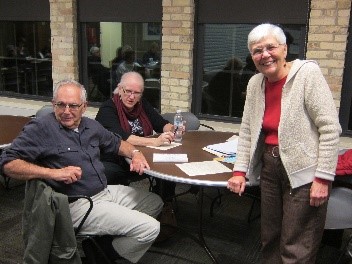
CHEW librarian Jean DeVore manages CHEW’s Traveling Library, a collection that totals nearly 100 titles ranging from The Home Indigenous Kitchen to Midwest Maize: How Corn Shaped the U.S. Heartland, to Six Spices: A Simple Concept of Indian Cooking. The full list of titles, many of them written by past CHEW speakers, is at http://www.chewwisconsin.com/culinary/traveling-culinary-history-enthusiasts-of-wisconsin-chew-library-collection/. Meeting attendees can borrow a book from the library by emailing chewwisconsin@gmail.com, and the book will be brought to the next meeting. Jean often gives informative book reports about titles from our collection at CHEW meetings.
CHEW’s Facebook page, at https://www.facebook.com/groups/chewwis, is peppered with links to fascinating food stories, historical resources, newspaper articles, political issues and culinary news–from salty licorice and blue moon ice cream, to ancient hot pots and the history of railroad cuisine. We also post notices about upcoming meetings.
CHEW is a “sister” to other food history groups in the United States. Cities and regions that have organizations similar to ours include Ann Arbor, Boston, Chicago, New York, Washington D.C., San Diego, and southern and northern California. Together we are loosely organized into an umbrella alliance called NACHO—the National Association of Culinary History Organizations.
Some Fun, Favorite and Fascinating CHEW Meeting Topics from Our Past
(For a full listing of past speakers and talk titles, see http://www.chewwisconsin.com/history/past-speakers-and-events/.
“Tibetan Momos from Tenzin’s Kitchen”
“Stacking Brooms: Food & Drink Traditions in American Curling Clubs”
“Pigs, Pork, and Heartland Hogs: From Wild Boar to Baconfest”
“The Life and Times of Carson Gulley”
“Good Seeds: A Menominee Food Memoir”
“Food in the Gilded Age: What Ordinary Americans Ate”
“Colby: The Comeback Kid”
“Old Fashioned: The Story of the Wisconsin Supper Club”
“Food Deserts: Concept, Controversy and Clarification”
“The Empire of the Tea Table: The Social and Literary Life of Tea in Victorian England”
“Fishing for Sustainability, Past and Present”
“Putting Down Roots: Gardening Insights and Inspiration from Wisconsin’s Early Settlers”
“The Cultural and Culinary Importance of the Apple”
“Food and Identity in Early Rabbinic Judaism”
“Hot Peppers in Pasty Territory: Food Pluralism in Southwestern Wisconsin”
“Why We Dine as We Do: The History of the Dining Table”
“A Recipe for Success: The Story of Lizzie Kander and the Settlement Cookbook”
Time to Eat
Thanks to the generosity of CHEW members and speakers who’ve cooked and shared dishes at meetings, we’ve tasted many famous, delicious or just plain curious foods over the years, including such delicacies as: butter tea; Lord Woolton pie; guerilla cookies; artisanal cheeses from Wisconsin; Tibetan momos; molded Jell-O; wild rice cakes; fudge bottom pie; Norwegian meatballs with rosemary cream sauce; hops tea; grass-fed beef; supper club relish trays; Oscar Mayer bologna; quince preserves; farm-raised yellow perch; hot dogs; Girl Scout cookies; homemade marshmallows; Swiss Colony fruitcake; chocolate truffles; and ravioli stuffed with chanterelle mushrooms, double-smoked bacon, shallots and cream.
By Terese Allen, published in CHEW’sletter, December 2020, for the occasion of CHEW’s 20th anniversary.

